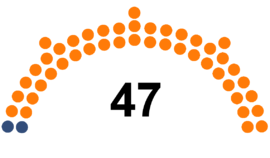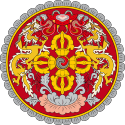- National Assembly of Bhutan
-
Coordinates: 27°29′23.2″N 89°38′17.5″E / 27.489778°N 89.638194°E
National Assembly of Bhutan
འབྲུག་གི་རྒྱལ་ཡོངས་ཚོགས་འདུ་
Druki Gyelyong TshogduType Type Lower house Leadership Speaker of the National Assembly Lyonpo Jigme Tshultim, DPT
since 24 March 2008Structure Members 47 
Political groups Government:
- DPT (45)
Opposition:
- PDP (2)
Elections Voting system First-past-the-post voting Last election 24 March 2008 Meeting place Gyelyong Tshokhang, Thimphu Website Official Website of the National Assembly of Bhutan Bhutan 
This article is part of the series:
Politics and government of
Bhutan- Constitution
- King (List)
- Dratshang Lhentshog
- Parliament
- National Council
- National Assembly
- Royal Court of Justice
- Supreme Court
- High Court
- Dzongkhag Courts
- Dungkhag Courts
- Council of Ministers
- Dzongkhags (List)
- Political parties
- Elections
- Foreign relations
The National Assembly is the elected lower house of Bhutan's new bicameral Parliament which also comprises the Druk Gyalpo (Dragon King) and the National Council. It is the more powerful house.
Contents
Current National Assembly
The current National Assembly has 47 members, who were elected in the first ever general elections on March 24, 2008. Jigme Thinley's Druk Phuensum Tshogpa Party won a landslide victory, securing 45 seats. The People's Democratic Party won the other two,[1] but its leader Sangay Ngedup lost the election in his constituency.[2]
Under the 2008 Constitution, the National Assembly consists of a maximum of 55 members directly elected by the citizens of constituencies within each Dzongkhag (District).[3] (Art. 12) Under this single-winner voting system, each constituency is represented by a single National Assembly member; each of the 20 Dzongkhags must be represented by between 2–7 members. Constituencies are reapportioned every 10 years.[3] (Art. 12, §§ 1–2) The National Assembly meets at least twice a year, and elects a Speaker and Deputy Speaker from among its members. Members and candidates are allowed to hold political party affiliation.
History
The National Assembly was originally decreed in 1953 by King Jigme Dorji Wangchuck. The National Assembly began as a unicameral parliament within the King's framework for democratization. In 1971, King Jigme Dorji empowered the National Assembly to remove him or any of his successors with a two-thirds majority. The procedure for abdication remains a part of Bhutan's Constitution of 2008, with the addition of a three-fourth majority in a joint sitting of Parliament (i.e., including the National Council) to confirm the involuntary abdication as well as a national referendum to finalize it.[3] (Art. 2)
See also
- Politics of Bhutan
- List of political parties in Bhutan
- Elections in Bhutan
- Parliament of Bhutan
- Bhutanese legislation
References
- ^ Majumdar, Bappa (March 27, 2008). "CORRECTED: Bhutan corrects poll results, opposition shrinks". Reuters. http://www.reuters.com/article/worldNews/idUSDEL16203420080327. Retrieved 2009-05-10.
- ^ "Bhutan votes for status quo", France 24, March 24, 2008
- ^ a b c "Constitution of the Kingdom of Bhutan (English)" (PDF). Government of Bhutan. 2008-07-18. http://www.constitution.bt/TsaThrim%20Eng%20(A5).pdf. Retrieved 2010-10-13.
External links
- "Official website of the National Assembly of Bhutan". http://www.nab.gov.bt/. Retrieved 2008-04-16.
Categories:- National lower houses
- Parliament of Bhutan
- 2007 establishments
- Bhutan stubs
Wikimedia Foundation. 2010.
